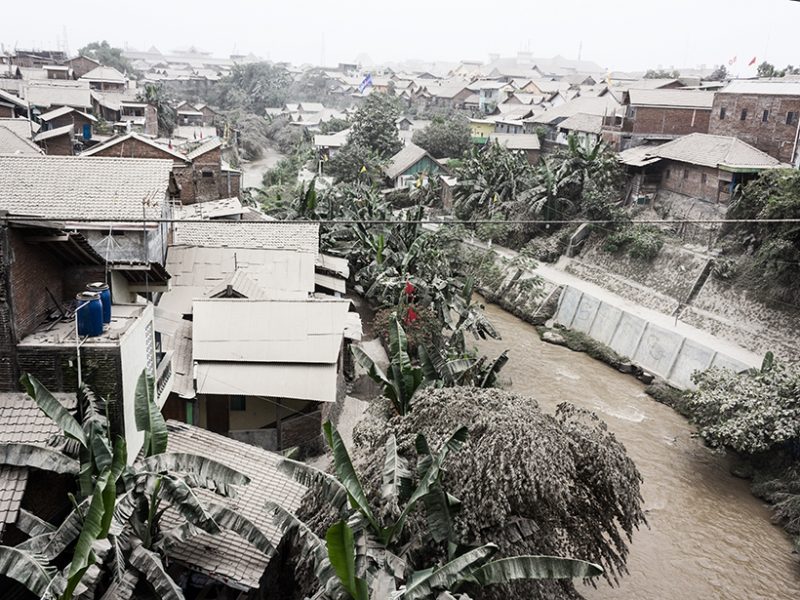O OVGA é um Centro de Ciência que desenvolve atividade de investigação aplicada e de divulgação científica na área da Vulcanologia, da Sismologia e da Geotermia.
Notícia -A A +A
Explosive Volcanic Eruption Powered by Water-Saturated Magma - Notícia OVGA 16-10-2019

The 2014 eruption of Kelud, a volcano in Indonesia, covered nearby neighborhoods in ash.
Credit: Crisco 1492, CC BY SA 3.0
Some volcanoes erupt almost gently, lava moving placidly down their sides. Others erupt explosively, launching plumes of ash high into the atmosphere and triggering gale-force pyroclastic flows. Kelud, an active stratovolcano in Indonesia, does both.
Scientists have now shown that the explosivity of Kelud’s last eruption, in 2014, was likely driven internally by volatile-triggered overpressure rather than an influx of magma. These results shed light on the causes of explosive eruptions, the most dangerous type of volcanic activity, the research team suggests.
Kelud (also known as Kelut), on the highly populated island of Java, has erupted both explosively and effusively eight times in the past 100 years, killing thousands of people. “It’s particularly active and also particularly unpredictable because it changes its eruption style,” said Mike Cassidy, a volcanologist at the University of Oxford in the United Kingdom.
Kelud’s most recent eruption, on 13 February 2014, launched a Plinian column 26 kilometers into the atmosphere. The explosive eruption blew down trees, caused roofs to collapse under thick layers of ash, and triggered the closure of multiple airports in Southeast Asia. There were few fatalities, however, thanks to a massive evacuation effort from Indonesia’s Center for Volcanology and Geological Hazard Mitigation.
Studying the 2014 Eruption
Using preeruption satellite imagery, seismic records, and samples of pumice and ash collected after the 2014 eruption, Cassidy and his colleagues analyzed Kelud’s magma system. They began by looking for evidence of ground deformation prior to the eruption, which is associated with moving magma and fluids. They didn’t find any. Furthermore, they found little to no preeruptive seismic activity, a puzzle because ground shaking often precedes eruptions.
“All of these things that we associate with big explosive eruptions just didn’t happen,” said Cassidy.
In the laboratory, Cassidy and his collaborators analyzed Kelud’s pumice to determine the temperature and pressure under the volcano. They combined coarsely crushed samples of Kelud pumice with water and carbon dioxide (volatiles that had been lost during the eruption), heated the material, and placed it under high pressure for several days.
The scientists conducted different experiments at various temperatures, pressures, and volatile ratios. “We do this for multiple experiments and compare this to chemical composition of the natural pumices and ash,” said Cassidy. “The best matches of the chemical compositions of the experiments to the natural products then represent the conditions that the magma was stored at.”
Cassidy and his team found that Kelud’s magma was stored at roughly 1,000°C–1,050°C and 50–100 megapascals. These conditions correspond to a depth of about 2–4 kilometers. That’s shallower than the magma reservoirs of other volcanoes, which typically exist 4–9 kilometers below the surface. “Kelud’s shallow storage depth may have added to the lack of pre-warning,” said Cassidy.
Cassidy and his colleagues furthermore showed that magma from Kelud’s explosive eruption in 2014 was more water rich than magmas from previous effusive eruptions.
That’s an important clue about the nature of this eruption, said Cassidy. Water-rich magmas contain volatiles, which increase the melt’s buoyancy and drive its ascent. Water is particularly effective at driving the upward movement of magma because it comes out of solution at a range of pressures.
“Those volatiles will act as hot air balloons and drag the magma upwards,” said Cassidy.
Overpressure caused by volatiles was the likely trigger of Kelud’s explosive eruption in 2014, Cassidy and his team suggest. “We attribute the greater explosivity of the 2014 eruption to its water-saturated nature,” the researchers concluded in their study, which was published in Geochemistry, Geophysics, Geosystems in July.
It’s important to study a “Jekyll-and-Hyde” volcano like Kelud, said Shane Cronin, a volcanologist at the University of Auckland in New Zealand not involved in the research. These results pave the way for new statistical forecasting models that combine “multiple independent pathways and processes to eruption.”
Cassidy and his team are looking forward to studying other volcanoes that erupt explosively and effusively, like Chile’s Volcán Quizapu and Indonesia’s Anak Krakatau. “We’re trying to understand where Kelud sits in the context of other eruptions.”
Fonte: eos.org (26-09-2019)
Adenda OVGA:
Localização do Monte Kelud (Indonésia)
